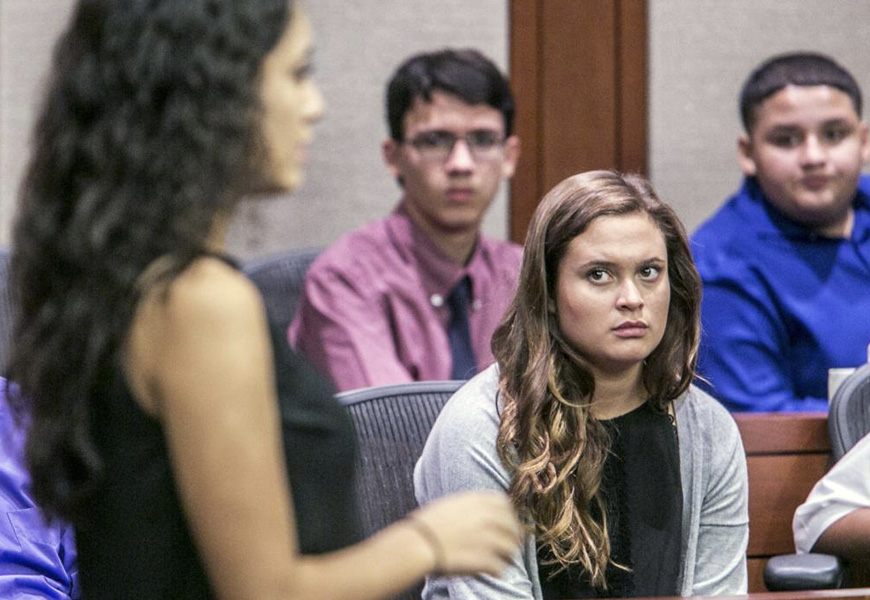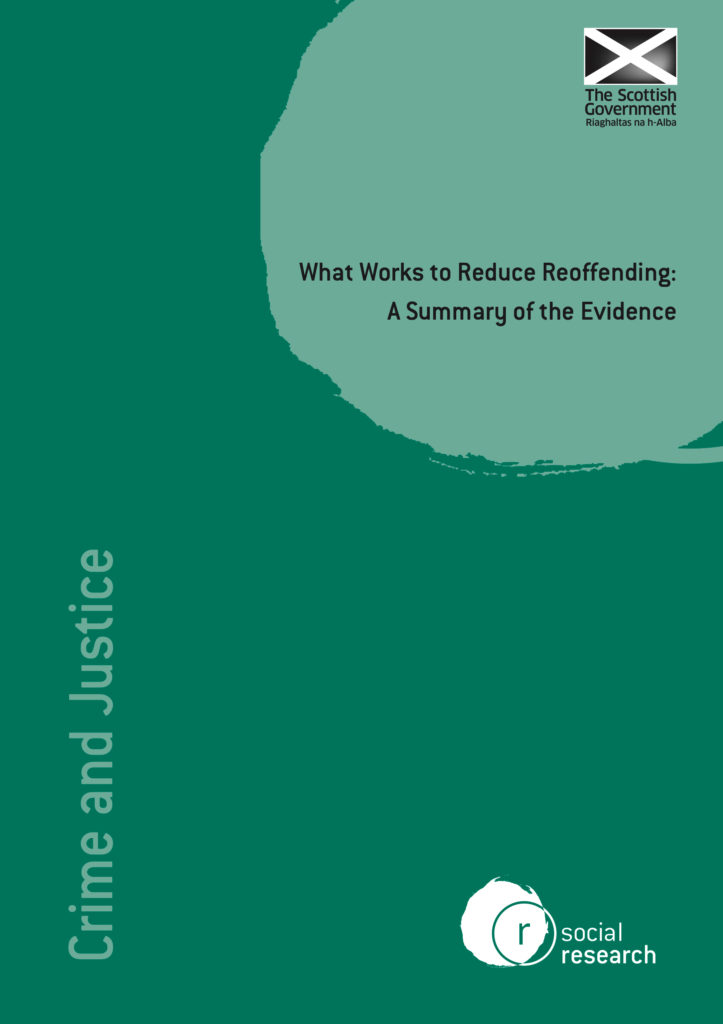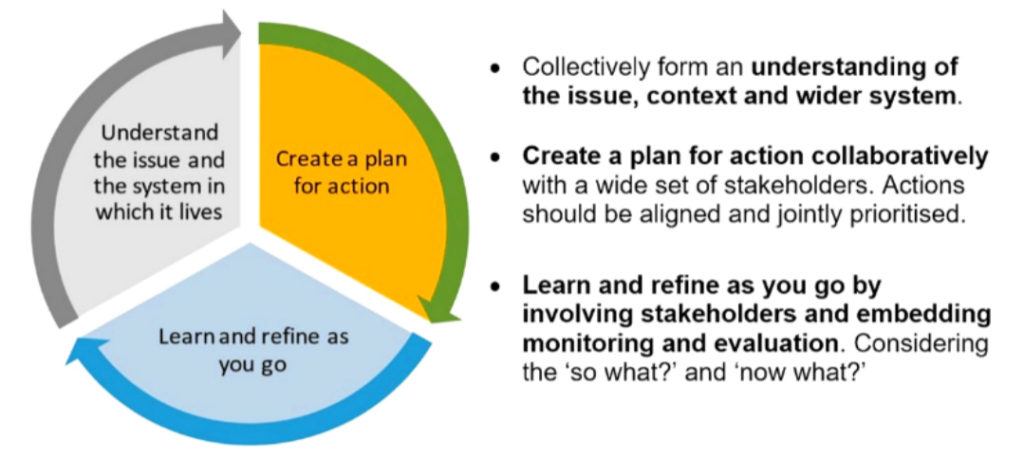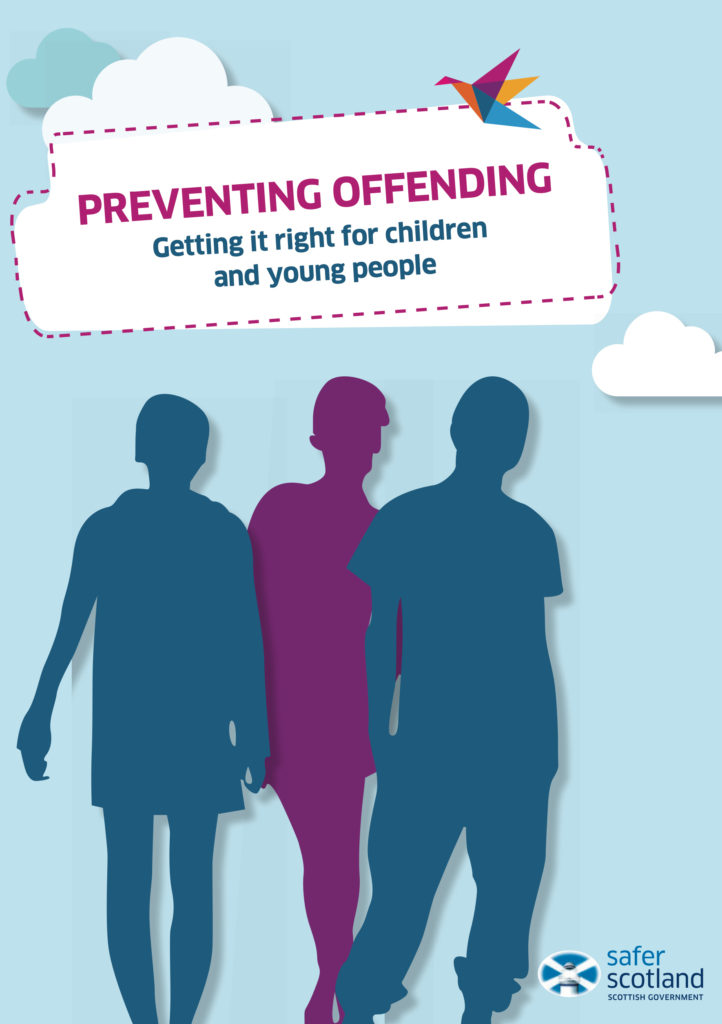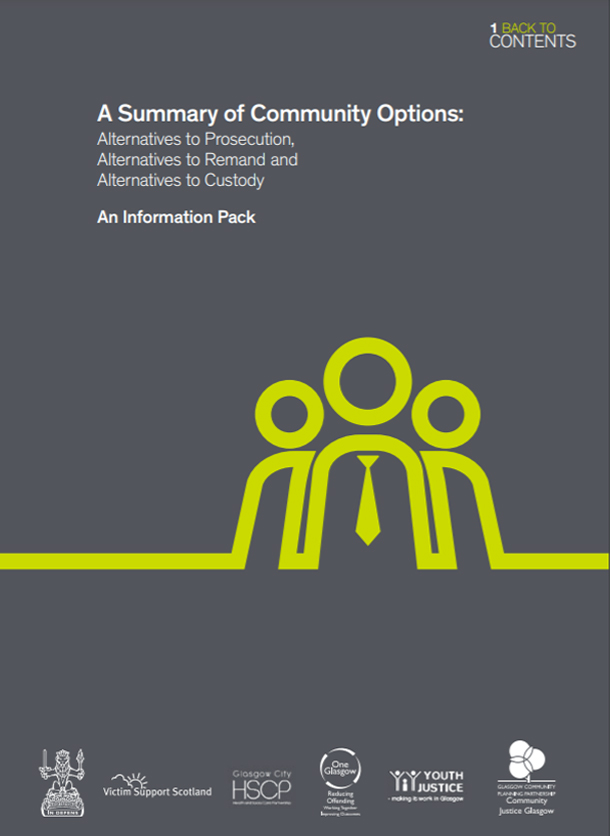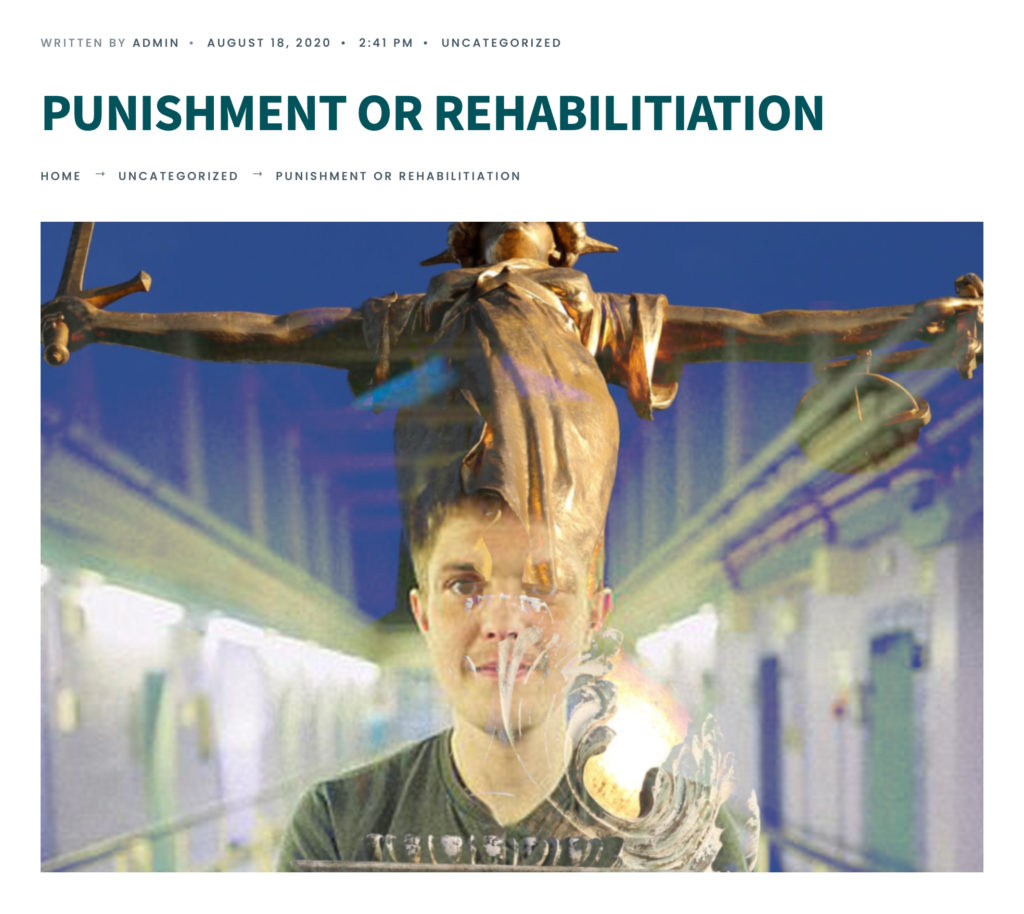Head of Service (Community Justice Services), Glasgow City Health & Social Care Partnership
We know from evidence – see for example the resources catalogued by Children & Young Peoples’ Centre for Justice (Figure 1) or the Scottish Government’s Summary of Evidence – What Works to Reduce Reoffending (Figure 2) – that it takes a Whole Systems Approach (see figure 3 for an example of the steps) to reduce reoffending amongst young people in our City.
As far as possible children should be kept out of formal measures, whether that be through the Children’s Hearings System or the Criminal Justice System, with proven alternative interventions utilised to address the behaviour and its causes. The Youth Court is only intended as an option for those young people were the Sheriff has made the decision not to remit to the Scottish Children’s Reporters Administration.
CLICK ON THE PICTURES BELOW TO ACCESS THE DOCUMENTS:
Put as simply as I can describe, a Whole Systems Approach is about identifying all of the parts/components/players that are linked or inter-related in a system (i.e. where a change to one part affects another) and bringing these components (be they financial resources, people resources, skills & knowledge, different organisations etc.) together to collaboratively plan and deliver actions to solve a problem that impacts on all of the parts of the system – in our case re-offending by young people.
The Whole Systems Approach in Glasgow around reducing reoffending amongst young people is underpinned by the Youth Justice Strategy – Preventing Offending – Getting it Right for Children & Young People (Figure 4). The planned Youth Court is an example of the strategy and our Whole Systems Approach in Glasgow in action.
About the Youth Court
The problem-solving court model uses the authority of the court to enhance the rehabilitative power of Community Sentences such as Community Payback Orders (CPOs) and Structured Deferred Sentences (SDS) – For a better understanding of the interventions noted you can read the Community Justice Glasgow publication A Summary of Community Options (Figure 5). The Glasgow Youth Court will combine the provision of multi-disciplinary intervention and support in the community, with regular court reviews to monitor and encourage young people’s progress.
To read more about rehabilitation in the justice context you can read the article in last year’s Annual Reporter – ‘Punishment or Rehabilitation – Balancing the Scales of the Justice System – Rhetoric or Reality)’ – CLICK ON THE LINK BELOW:
The ethos of the problem-solving court for young people is to create a direct link between the young person and the sentencing Sheriff. This approach allows for a more coordinated, tailored disposal to be developed between the Sheriff, the Social Worker and the young person, which better meets the needs of the young person. Anecdotally in Glasgow, we are seeing a greater concentration of children with complex needs coming to court, key features of the problem-solving approach are especially relevant for these young people.
As part of our commitment to improving outcomes for children, young people and their families by developing services that seek to reduce risk of escalation for young people who are involved with the criminal justice system, the key aims of the problem solving court are to:
- Improve sentencing and outcomes for young people aged between 16-21 years initially, with a view to extending this to all young people aged up to 25 years;
- Reduce the number of young people being sentenced to higher tariff disposals such as Community Payback Orders in Glasgow.
In the latter – Structured Deferred Sentences would be used to divert young people from the criminal justice system and reduce short term prison sentences. As part of the scheme a young person convicted of an offence will be provided with a period of time between conviction and sentencing in which they receive structured intense support to address the issues in their lives contributing to their offending behaviour. If during the deferral period they commit no further offences, then they may receive a lowered sentence or only a reprimand.
We have seen evidence from our visit to Hamilton Sheriff Youth Court and the evaluation of the South Lanarkshire Structured Deferred Sentencing for Young People (Dr Miller, 2019), that this model can assist young people to reduce reoffending whilst safeguarding and supporting them to reach their full potential and thrive within their local communities.
We know from locally collected data that the majority of young people under the age of 21 are made subject to Community Payback Orders (table one below), but we also know from national performance data that this age group have the lowest successful completion of this type of order (Figure 6).
Figure 6 – CPO Completion Rates by Age
Completions/Discharges of Community Payback Orders by Gender, Age & Employment Status: 2019-20
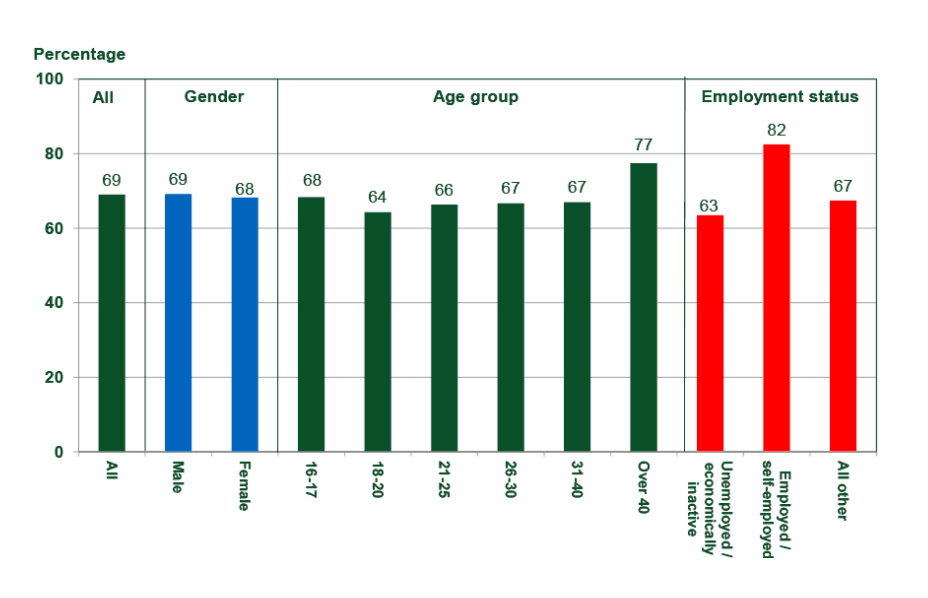
Community Payback Orders therefore are not always the most suitable community sentence for young people, as they tend to be longer in length and have strict requirements which the young person cannot always meet. We know that on average up to 40% of young people aged 18 years and under do not complete Community Payback Orders and breach which often results in further offences for young people.
When this is compared to national Structured Deferred Sentence statistics, deferred sentencing has a 77% completion rate. The statistics on deferred sentences do not provide a breakdown of completion rate via age, but we know 33% of all deferred sentences are young people. The Youth Court in Lanarkshire showed promising early data with completion rates of 82% (Dr Miller, 2019).
One of the key measures of success for the Structured Deferred Sentence Youth Court will be an overall reduction in the number of Community Payback Orders made and an increase in the number of Structured Deferred Sentences, given the data highlighted above. This would require a change in sentencing practice amongst the judiciary in Glasgow Sheriff Court.
Local Glasgow City Health & Social Care Partnership snapshot data (2019 unpublished) showed that amongst 16–21 year old population we had 284 Community Payback Orders and only 18 Structured Deferred Sentences (Table 1). Amongst 16-25 year olds we had 578 Community Payback Orders and 29 Structured Deferred Sentences (Table 2).
Table 1 – Snapshot of Disposals Aged 16-21 (2019)

Table 2 – Snapshot of Disposals Aged 16-25 (2019)
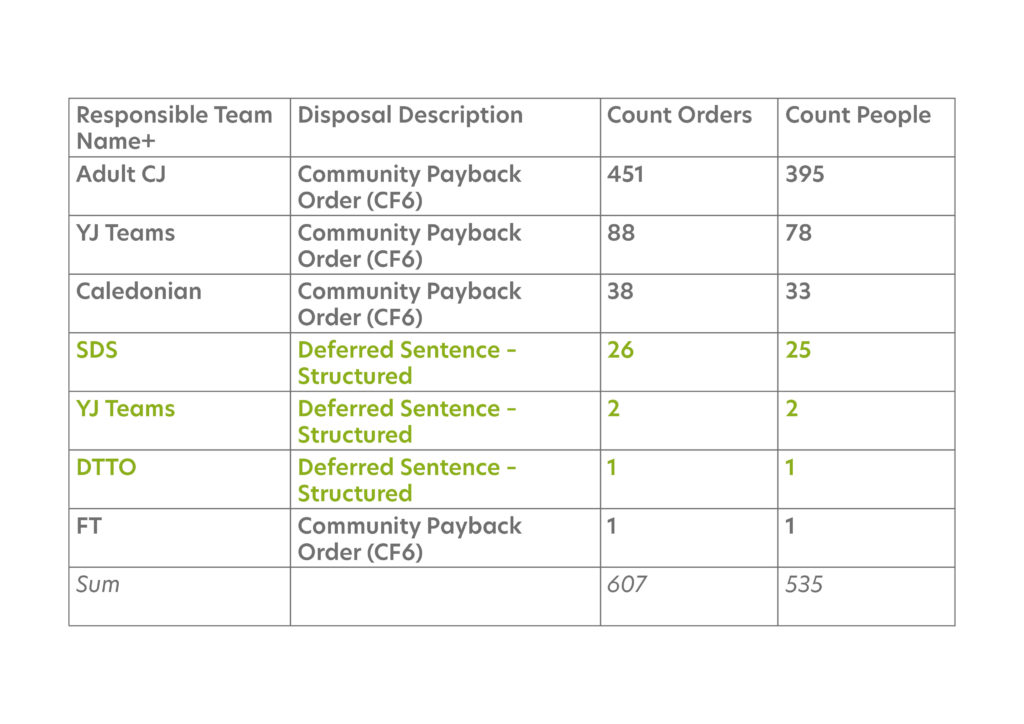
Our aim is to rebalance the number of Community Payback Orders being made and increase the number of Youth Court Structured Deferred Sentences – but we appreciate not all young people will be suitable for Structured Deferred Sentence given the serious nature of their offending. It is therefore hard to predict how far the pendulum will swing towards Structured Deferred Sentences, but by offering the court a robust and credible alternative to Community Payback Orders we hope to build judicial confidence in the Youth Court team in turn driving up the number of Structured Deferred Sentences.
Since the introduction of the Community Justice (Scotland) Act 2016 and the National Strategy for Community Justice we have worked closely to strengthen the partnership between Health and Criminal/Community Justice. Indeed in Glasgow, Community Justice has been integrated into the planning for Community Health and Social Care Services under the function and structure of the Public Bodies (Joint Working) (Scotland) Act 2014 bringing Community Justice Services under the leadership of the Glasgow City Health & Social Care Partnership Integration Joint Board. The partnerships between Health & Justice that have built and grown over this time have been key in continuing to improve the scope, reach and quality of services to support young people who come into contact with the justice system.
This partnership is essential in creating intensive bespoke support packages for each young person. The range of support made available to the young person will include existing Glasgow Health & Social Care Partnership services and local self-funded organisations which have the aim of improving outcomes for young people in terms of offending, employability and social support services. We aim to engage agencies to provide additional support in the following areas:
- Education and Employability
- Mental Health Support
- Addiction Interventions
- Housing and Community Support
- Social and Wellbeing
Without the confidence, knowledge and understanding that we have built over this time – through the lens of partnership – we would not be in the strong position we are today to deliver this. For example, third sector organisation Includem have received funding from Scottish Government to support young people involved in the justice system in Glasgow and have now created a dedicated team. We have met with Includem and have agreed to provide ringfenced support to the Youth Court team and will play a significant role in the action plans for young people. The main support provided by Includem will be mentoring, employability, learning and training, money management, relationships and family support.
Evaluation – We have built in evaluation at the start of the project and have identified several areas which could be evaluated to determine the success of the test of change. Progress towards these can be considered in turn based on the evidence collated as part of a mid-term review.
Evaluation will focus the following:
- monitoring the reduction of Community Payback Orders being made by Glasgow Sheriff Court;
- assessing the overall efficacy of a Structured Deferred Sentence approach for young people aged 16 to 21 years;
- considering whether compliance rates have improved using such an approach over other community-based options;
- the effectiveness of the intervention in reducing re-offending and improving outcomes and sustainable opportunities for young people;
- improved mental health and wellbeing, reduction in alcohol/substance misuse and stable housing; and
- identifying whether a reduction is experienced in young people receiving a custodial sentence.
The Youth Court will be implemented over 2021-22 and I look forward to reporting on progress – WATCH THIS SPACE!

